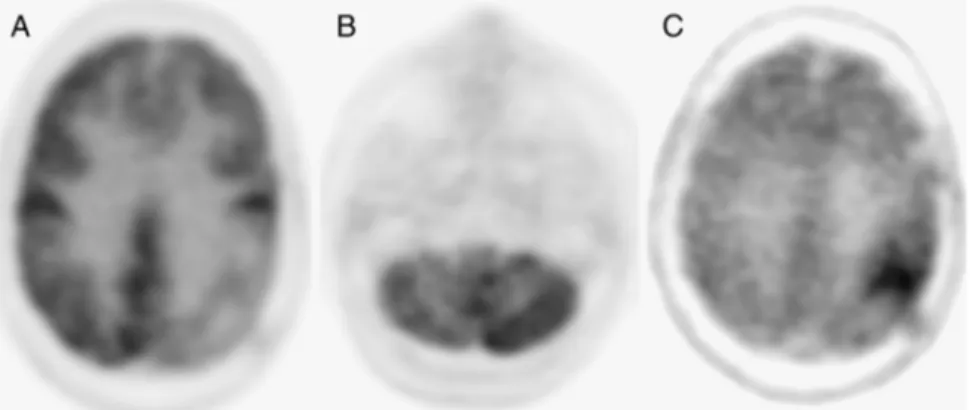Recurrent Glioma and Crossed Cerebellar Diaschisis in a Patient
Examined With
18
F-DOPA and
18
F-FDG PET/CT
Ferdinando Calabria, MD,* and Orazio Schillaci, MD*Þ
Abstract: Two years after resection of a left parietal glioma, a 46-year-old woman underwent18F-FDG and18F-DOPA brain PET/CT. FDG showed left
parietal hypometabolism with crossed cerebellar diaschisis. No abnormally increased FDG activity was seen.18F-DOPA PET/CT scan demonstrated focal
left parietal uptake. Recurrent glioma was confirmed by surgical biopsy.
18
F-DOPA may demonstrate abnormal amino acid metabolism in evaluation of recurrence of glioma.
Key Words:18F-DOPA,18F-FDG, PET/CT, brain tumor recurrence, crossed
cerebellar diaschisis
(Clin Nucl Med 2012;37: 878Y879)
REFERENCES
1. Tripathi M, Sharma R, Varshney R, et al. Comparison of F-18 FDG and C-11 methionine for the evaluation of recurrent primary brain tumors. Clin Nucl Med. 2012;37:158Y163.
2. Kanhaiya LA, Bhagwant RM, Anish B, et al. Crossed cerebellar diaschisis on F-18 FDG PET/CT. Indian J Nucl Med. 2011;26:102Y103.
3. Shih WJ, Huang WS, Milan PP. F-18 FDG PET demonstrates crossed cerebel-lar diaschisis 20 years after stroke. Clin Nucl Med. 2006;31:259Y261. 4. Gonzalez-Forero M, Prieto E, Domingues I, et al. Dual time point18F-DOPA
PET as a tool for characterizing brain tumors. Rev Esp Med Nucl. 2011; 30:88Y93.
5. Fueger BJ, Czernin J, Cloughesy T, et al. Correlation of 6-18F-fluoro-L-DOPA
PET uptake with proliferation and tumor grade in newly diagnosed and re-current gliomas. Clin Nucl Med. 2011;36:650Y655.
6. Tripathi M, Sharma R, D’Souza M, et al. Comparative evaluation of F-18 FDOPA, F-18 FDG and F-18 FLT-PET/CT for metabolic imaging of low grade gliomas. Clin Nucl Med. 2009;34:878Y883.
7. Santra A, Kumar R, Sharma P, et al. Detection of recurrence in glioma: a comparative study between Tc-99m GHA SPECT and F-18 FDG PET/CT. Clin Nucl Med. 2011;36:650Y655.
8. Chen W, Silverman DH, Delaloye S, et al.18F-FDOPA PET imaging of brain
tumors: comparison study with18F-FDG PET and evaluation of diagnostic
accuracy. J Nucl Med. 2006;47:904Y911.
9. Ledezma CJ, Chen W, Sai V, et al.18F-DOPA PET/MRI fusion in patients with
primary/recurrent gliomas: initial experience. Eur J Radiol. 2009;71:242Y248. 10. Calabria F, Chiaravalloti A, Di Pietro B, et al. Molecular imaging of brain tumors with 18F-DOPA PET and PET/CT. Nucl Med Commun. 2012; 33:563Y570.
I
NTERESTING
I
MAGE
878
www.nuclearmed.com
Clinical Nuclear Medicine
&
Volume 37, Number 9, September 2012
Received for publication February 16, 2012; revision accepted May 30, 2012. From the *Department of Nuclear Medicine and Molecular Imaging, IRCCS
Neuromed, Pozzilli (IS); and †Department of Biopathology and Diagnostic Imaging, University ‘‘Tor Vergata,’’ Rome, Italy.
Conflicts of interest and sources of funding: none declared.
Reprints: Ferdinando Calabria, MD, Department of Nuclear Medicine and Molecular Imaging, IRCCS Neuromed, Via Atinense 18, 86077 Pozzilli (IS), Italy. E-mail: [email protected].
Copyright* 2012 by Lippincott Williams & Wilkins ISSN: 0363-9762/12/3709-0878
